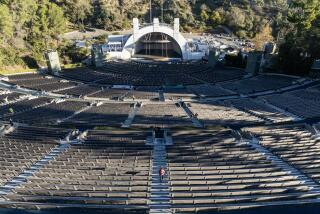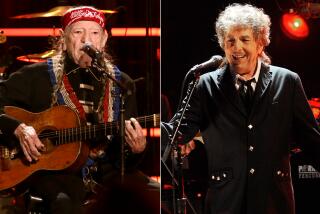That Bowl magic
- Share via
Cars didn’t have seat belts back in the 1940s -- but then, nobody was thinking too hard about safety when Charla Janacek and her pals from Glendale’s Hoover High showed up for volunteer usher duty at the Hollywood Bowl with six to eight kids piled into one vehicle.
As Janacek describes it, the scene was less traditional carpool than clown car. “Some of us were in the seats, some of us were on the floor,” she recalls with a loud laugh. “We were stacked, woven, like the lattice top on an apple pie. The security police would come and help us out of the car.”
Sometimes it was a student driving the family car; other times, Janacek’s dad played chauffeur in his Pontiac. But no matter who drove, the goal was the same: to spend as much time as possible at the Bowl.
Janacek’s first year as a Bowl usher was 1941; she was 16. Today at 84, Janacek still jumps at the chance to take in a concert under the stars in Cahuenga Pass -- although she may not jump quite as high as she used to.
While the Bowl serves as one of the city’s most popular tourist draws, to many who have grown up here, the summer venue for the Los Angeles Philharmonic is less an attraction to visit than a place to call home.
In advance of the Bowl’s summer concert series, which gets underway Tuesday, three of those longtime Bowl-goers shared their decades of memories with The Times. (We were not able to locate anyone who was seated on the benches when the Bowl first opened in 1922.) All three are passing on the tradition to their children and grandchildren -- and even sometimes to perfect strangers when they have an extra ticket to spare.
Janacek started her lifetime at the Bowl in the back rows; although she and her friends were not paid for their usher duties, they got to keep a penny for every 10-cent program they sold. “By the time they got up to the back rows, nobody wanted a program,” Janacek recalls. While her friends were pulling down $2 and $3 a night closer to the stage, her average take was 9 cents.
“After the concerts, we’d all go out for a hamburger at Bob’s in Burbank, and I only made enough money one night to pay for the hamburger,” she laments. “My poor mother had to subsidize my social life.”
Alyce de Roulet Williamson, 78, got a slightly different view -- from a box that has been in her family for more than 50 years. The Pasadena socialite and philanthropist has occupied a garden box with her husband, retired investment banker Warren “Spud” Williamson, since they were married in 1954.
The Williamsons inherited the box from Alyce’s parents, Henry and “Dawnie” de Roulet. Warren Williamson is the grandson of the late Harry Chandler, former publisher of The Times; he is chairman of the Chandler Trust and a member of the L.A. Phil’s board of directors.
“I can’t bear the thought of giving up the box,” says Williamson, who attended this year’s opening night concert, featuring opera star Kiri Te Kanawa and pop sensation Josh Groban on June 19 with family and friends; for this concert, they sat not in the longtime family box but in a Pool Circle box, so called because they occupy an area once taken up by a reflecting pool. “It used to be when I would go to the Bowl, I knew everybody there, it was big time. And everybody dressed up.”
Now, Williamson says, the couple’s love of horse racing often keeps her away from the Bowl, but she’s still usually in the family box for the Tuesday night classical music series. “I love that -- there’s no racing on Tuesday nights,” she says.
Physician John Uphold, who lives in Hermosa Beach and has a practice in Woodland Hills, has experienced the Bowl from both the last and first rows. Uphold admits that as a child in the 1950s, growing up in Whittier, he was a reluctant Bowl-goer, dragged to classical concerts by his parents.
“We would go and sit in the benches, pretty far back, because I remember the walks up,” he says. “We would picnic on the benches -- everyone was in a long line, so the potato salad would always be about 8 feet away from you.
“I had a paper route, and had gotten a small transistor radio for getting new subscribers,” he reminisces. “I’d listen to the Dodger games with a little earphone. I remember it was a very quiet time, and somebody hit a home run and I let out a whoop. I incurred a certain amount of wrath for that; I learned that was not an acceptable way to celebrate during a concert. I got to keep the radio, but had to promise that was never going to happen again.”
Uphold went to Texas for his medical education, but when he returned to Los Angeles in 1975, he and his family returned to the Bowl -- and got his first box. “It was in the last row of boxes, the last row of the terrace, off to one side, but I was happy because I got a box,” he says. Over the years, he managed to keep moving down to more and more desirable boxes by subscribing to new music series as they were added to the schedule. “There wasn’t as much demand for them,” he says. He now sits front row center in the Pool Circle.
But Uphold has not forgotten his roots: When the demands of his medical career require him to leave a concert at intermission, he climbs up to the back rows and taps patrons from the less expensive seats to come down and occupy the box. “That’s where I started,” he says. “And going from the bottom to the top and back down again tells me that I’m still in shape.”
His wife, Judi, observes: “They used to think he was half-mad, some kind of a crazy guy, but he used to say, ‘I used to sit back there and wonder who was up front.’ ”
Although the Hollywood Bowl got a new, larger and acoustically improved orchestra shell in 2004, the three longtime patrons say the feel of the outdoor venue hasn’t really changed. And all praise the large screens that allow patrons in the back rows a better view of the action onstage.
But a few things were different at the Bowl in the ‘40s and ‘50s; for Uphold, the biggest change upon returning to the Bowl after med school was that the reflecting pool, as well as the fountains that danced at intermission, had been removed, in 1972. “It was part of the entertainment, but it wreaked havoc with the musicians,” he says. “And I think everybody remembers when the Beatles came to the Bowl and everybody went into the pools, it became a security issue,” he says, referring to the concert the Fab Four gave for 18,000 screaming fans in 1964. “The time had come, I think.”
Janacek remembers that there were more technical glitches in the old days when it came to special effects. “I don’t remember the year, it must have been in the ‘50s -- it was a Tchaikovsky night, and the orchestra was on a platform out over the pool, so they were out of the shell,” she recalls. “They had the USC marching band, and two cannons on each side of the stage. And the band was marching and everyone was clapping, and they shot off the cannons. And up went the smoke and the soot, and it covered the orchestra; they were still playing, but they were all coughing -- it was horrible. I’ll tell you something, they never had cannons again.”
What the three find most rewarding these days is playing a role in bringing new audiences to the Bowl. As an adult, Janacek would buy up a whole row of inexpensive seats near the back and dole them out to her extended family and friends, kids in tow. “It was about appreciation -- my whole life was about music appreciation,” she says. “Nobody was ever headed for being a professional, but I wanted them to know, when you see someone doing something, how hard it was for them to have done it.”
Uphold says his proudest moment was when his daughters, aspiring singer Rory and Cassen, now in their early 20s, first wanted to go to the Bowl on their own, in their late teens. “It was a proud moment, because obviously, the baton had been passed,” he says.
And, for her part, Williamson says she discovered something new at the Bowl -- the lure of the back rows. “My niece came out from New York, and we scalped our tickets and sat way up high to see a country-western singer, Bonnie Raitt,” and I loved it,” she says. “And I want to tell you, that was magical, sitting way up there, where the seats are way up high. . . . “
--
More to Read
The biggest entertainment stories
Get our big stories about Hollywood, film, television, music, arts, culture and more right in your inbox as soon as they publish.
You may occasionally receive promotional content from the Los Angeles Times.










